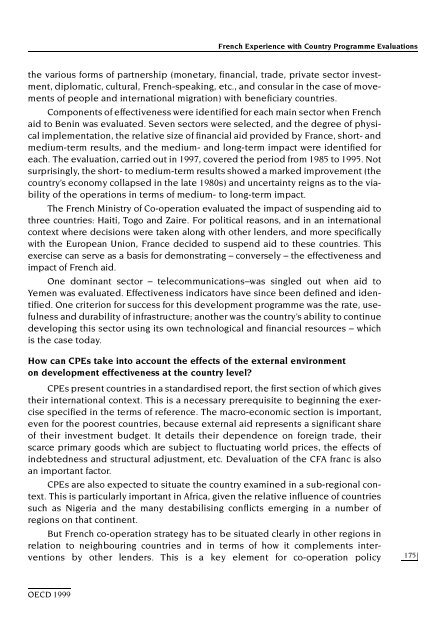Evaluating Country Programmes - OECD Online Bookshop
Evaluating Country Programmes - OECD Online Bookshop
Evaluating Country Programmes - OECD Online Bookshop
Create successful ePaper yourself
Turn your PDF publications into a flip-book with our unique Google optimized e-Paper software.
<strong>OECD</strong> 1999<br />
French Experience with <strong>Country</strong> Programme Evaluations<br />
the various forms of partnership (monetary, financial, trade, private sector investment,<br />
diplomatic, cultural, French-speaking, etc., and consular in the case of movements<br />
of people and international migration) with beneficiary countries.<br />
Components of effectiveness were identified for each main sector when French<br />
aid to Benin was evaluated. Seven sectors were selected, and the degree of physical<br />
implementation, the relative size of financial aid provided by France, short- and<br />
medium-term results, and the medium- and long-term impact were identified for<br />
each. The evaluation, carried out in 1997, covered the period from 1985 to 1995. Not<br />
surprisingly, the short- to medium-term results showed a marked improvement (the<br />
country’s economy collapsed in the late 1980s) and uncertainty reigns as to the viability<br />
of the operations in terms of medium- to long-term impact.<br />
The French Ministry of Co-operation evaluated the impact of suspending aid to<br />
three countries: Haiti, Togo and Zaire. For political reasons, and in an international<br />
context where decisions were taken along with other lenders, and more specifically<br />
with the European Union, France decided to suspend aid to these countries. This<br />
exercise can serve as a basis for demonstrating – conversely – the effectiveness and<br />
impact of French aid.<br />
One dominant sector – telecommunications–was singled out when aid to<br />
Yemen was evaluated. Effectiveness indicators have since been defined and identified.<br />
One criterion for success for this development programme was the rate, usefulness<br />
and durability of infrastructure; another was the country’s ability to continue<br />
developing this sector using its own technological and financial resources – which<br />
is the case today.<br />
How can CPEs take into account the effects of the external environment<br />
on development effectiveness at the country level?<br />
CPEs present countries in a standardised report, the first section of which gives<br />
their international context. This is a necessary prerequisite to beginning the exercise<br />
specified in the terms of reference. The macro-economic section is important,<br />
even for the poorest countries, because external aid represents a significant share<br />
of their investment budget. It details their dependence on foreign trade, their<br />
scarce primary goods which are subject to fluctuating world prices, the effects of<br />
indebtedness and structural adjustment, etc. Devaluation of the CFA franc is also<br />
an important factor.<br />
CPEs are also expected to situate the country examined in a sub-regional context.<br />
This is particularly important in Africa, given the relative influence of countries<br />
such as Nigeria and the many destabilising conflicts emerging in a number of<br />
regions on that continent.<br />
But French co-operation strategy has to be situated clearly in other regions in<br />
relation to neighbouring countries and in terms of how it complements interventions<br />
by other lenders. This is a key element for co-operation policy<br />
175

















![CQE=U]^\]Z: KAZAKHSTAN - OECD Online Bookshop](https://img.yumpu.com/3915768/1/190x253/cqeuz-kazakhstan-oecd-online-bookshop.jpg?quality=85)